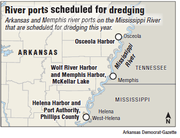The U.S. Army Corps of Engineers will spend more than $7 million this year on dredging 10 Mississippi River ports in four states to open channels that are often clogged by silt and sediment from upstream.
The project -- which will be done at ports in Arkansas, Kentucky, Missouri and Tennessee -- is one of the largest undertakings of dredging by the Corps in years, spokesman Jim Pogue of Memphis said.
Two ports in Helena-West Helena, one in Osceola and two in Memphis are among the 10 scheduled for the work this summer and fall.
"When the river level is low and the river moves slower, the silt settles and accumulates at the entrances to harbors," Pogue said. "That hinders [barge] traffic from entering or leaving."
Record flooding in 2011 churned up more silt and debris in the Mississippi River. That, coupled with reduced funding for dredging of smaller river ports, created the silt problems.
"It's vital for the future of Helena," said John Edwards, economic development director for the Phillips County Port Authority in Helena-West Helena.
"It's not reached a critical situation. The Corps dredged a bit last year. But we were getting concerned that if we didn't get the dredging this year, it would make things pretty tough."
Two ports in Helena-West Helena -- the Phillips County Port Authority, downstream from the U.S. 49 bridge, and the "Old Helena" port downtown -- will receive dredging.
Col. Jeff Anderson, commander of the Corps of Engineers' Memphis District, said the Corps will spend $7,406,100 on the dredging project.
In the recent past, the U.S. Congress cut funding for harbor dredging on the basis of traffic at various ports. Smaller ports were left federally unfunded, and some ports resorted to contracting private dredging companies just to keep the harbors open, Pogue said.
Managers of several river harbors on the Lower Mississippi River formed a coalition and lobbied Congress for additional funding, Pogue said.
The coalition helped spur a bipartisan effort -- led by U.S. Sen. David Vitter, R-La., and U.S. Sen. Barbara Boxer, D-Calif., who was the chairman of the Senate Environment and Public Works Committee -- to help ensure more federal money would be available for dredging projects.
"It worked," Pogue said. "They were able to get more funding released. It was quite a success story."
The ports and funding received are:
• Elvis Stahr Harbor, Hickman, Ky., $625,000.
• Northwest Tennessee Regional Harbor, Tiptonville, Tenn., $380,000.
• New Madrid Harbor, River Mile 889, New Madrid, Mo., $420,100.
• New Madrid County Harbor, New Madrid, Mo., $327,000.
• Caruthersville Harbor, Caruthersville, Mo., $437,000.
• Wolf River Harbor, Memphis, $468,000.
• Memphis Harbor-McKellar Lake, Memphis, $2,892,000.
• Helena Harbor, Helena-West Helena, $476,000.
• Phillips County Port Authority, Helena-West Helena, $541,000.
• Osceola Harbor, Osceola, $840,000.
Work is to begin later this summer and last through October, Pogue said.
Corps dredging units, like the Dredge Wheeler, which has its own Facebook page, use vacuumlike equipment to pick up silt and sediment from the harbor's river bottom.
Larger ships can clean 100,000 cubic yards of silt a day, which is equivalent to 7,000 dump-truck loads.
"We tell prospective businesses looking to locate here that we have river, rail and roads," Edwards said. "One of the most attractive elements is our harbor."
The Helena-West Helena port is 2.5 miles long and 300 yards wide.
Helm Fertilizer Corp. maintains a dock there, shipping products in and out of the harbor.
Gov. Asa Hutchinson is to dedicate the Enviro Tech facility at the port Tuesday. The company, based in Modesto, Calif., manufactures liquid, biodegradable disinfectants for the food industry.
Mississippi Limestone Corp. also has a dry dock at the harbor for barge repair work, Edwards said.
Upstream at Osceola, the port in the Mississippi County town sees about 600 barges enter its harbor a year, said port manager Jeff Worsham.
They have two grain elevators at the port and provide the nearest barge transport within a 100-mile radius, he said.
"We are very important," he said of the harbor. "About 90 percent of all the grain leaving this area goes out on the river.
"If we don't get dredged, we run into problems."
State Desk on 03/30/2015
